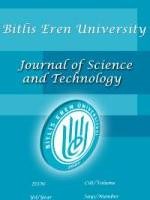Performance prediction of a single-stage refrigeration system using R134a as a refrigerant by artificial intelligence and machine learning method
Performance prediction of a single-stage refrigeration system using R134a as a refrigerant by artificial intelligence and machine learning method
In this study, COP and heat capacities of evaporator and condenser were calculated by artificial intelligence and machine learning method in a vapor compression mechanical refrigeration cycle using well-known R134a as a refrigerant. Dataset was obtained with CoolPack software to train the model. Evaporating, condensing, superheating and subcooling temperatures are selected as input data. COP, heat capacities of evaporator and condenser are included in the dataset as target values. Artificial Neural Network (ANN) model was created with Matlab R2018b software and validated with target data. The output files obtained were compared with the target files and it was found that the mean square error value was quite close to one. The results of this study show that the ANN method can be used to obtain cycle parameters in one stage refrigeration cycle with high accuracy.
Keywords:
Artificial neural networks, Refrigeration cycle, Artificial intelligence, Machine learning Thermodynamics,
___
- [1] N.E. Klepeis, W.C. Nelson, W.R. Ott, J.P. Robinson, A.M. Tsang, P. Switzer, J. V. Behar, S.C. Hern, W.H. Engelmann, The National Human Activity Pattern Survey (NHAPS): A resource for assessing exposure to environmental pollutants, J. Expo. Anal. Environ. Epidemiol. 11 (2001) 231–252. doi:10.1038/sj.jea.7500165.
- [2] T. Akimoto, S. ichi Tanabe, T. Yanai, M. Sasaki, Thermal comfort and productivity - Evaluation of workplace environment in a task conditioned office, Build. Environ. 45 (2010) 45–50. doi:10.1016/j.buildenv.2009.06.022.
- [3] S. ichi Tanabe, M. Haneda, N. Nishihara, Workplace productivity and individual thermal satisfaction, Build. Environ. 91 (2014) 42–50. doi:10.1016/j.buildenv.2015.02.032.
- [4] P. Wargocki, D.P. Wyon, j. Sundell, G. Clausen, P.O. Fanger, The Effects of Outdoor Air Supply Rate in an Office on Perceived Air Quality, Sick Building Syndrome (SBS) Symptoms and Productivity, Indoor Air. 10 (2000) 222–236. doi:10.1034/j.1600-0668.2000.010004222.x.
- [5] P. and C.E.U. European Commission Joint Research Centre, Institute For Health and Consumer Protection, Ventilation, good indoor air quality and rational use of energy, Rep. No. 23, EUR20741 EN. (2003).
- [6] B. Kılıç, Alternative Approach For Thermal Analysis Of Transcritical Co2 One-Stage Vapor Compression Cycles, Int. J. Eng. Appl. Sci. 8 (2016) 1–1. doi:10.24107/ijeas.251263.
- [7] M. Hosoz, H.M. Ertunc, Modelling of a cascade refrigeration system using artificial neural network, Int. J. Energy Res. (2006). doi:10.1002/er.1218.
- [8] Ö. Kizilkan, A.Ş. Encan, K. Yakut, R410a Soğutucu Akişkaninin Termodina Ik Özelliklerinin Yapay Sinir Ağlari Metoduyla Modellenmesİ, 21 (2006) 395–400.
- [9] S. Yilmaz, K. Atik, Modeling of a mechanical cooling system with variable cooling capacity by using artificial neural network, Appl. Therm. Eng. 27 (2007) 2308–2313. doi:10.1016/j.applthermaleng.2007.01.030.
- [10] R. Yamankaradeniz, İ. Horuz, Ö. Kaynakli, S. Coşkun, N. Yamankaradeniz, Soğutm tekniği ve Isı Pompası Uygulamaları, 3., DORA, Bursa, 2013.
- [11] S.A. Kalogirou, Artificial neural networks in renewable energy systems applications: A review, Renew. Sustain. Energy Rev. (2000). doi:10.1016/S1364-0321(01)00006-5.
- [12] H. Yağlı, A. Koç, A. Yapıcı, H.H. Bilgiç, Deneysel Bi̇r Organi̇k Ranki̇n Çevri̇mi̇nde YapaSi̇ni̇r Ağlari (Ysa) Yardimiyla Güç Tahmi̇ni̇, Selcuk Univ. J. Eng. ,Science Technol. 4 (2016) 7–7. doi:10.15317/scitech.2016116091.
- Yayın Aralığı: Yılda 2 Sayı
- Başlangıç: 2011
- Yayıncı: Bitlis Eren Üniversitesi
Sayıdaki Diğer Makaleler
The relationship between nitric oxide and cadmium toxicity in wheat (triticum aestivum L.) seedlings
Songül ÇANAKCI GÜLENGÜL, Ayşe Dilek ÖZŞAHİN KİREÇCİ, Tuba OKUTAN
Enver Fehim KOÇPINAR, Murat KÜRŞAT, Ahmet SAVCI, Yusuf ALAN
The effect of different negative parameters on the performance of steel structures
Ercan IŞIK, Berfin KAYA, İbrahim Baran KARASİN
Orbital period behaviour of three semi-detached binaries AI Cru, V1898 Cyg and Z Vul
Augmented reality practices in health services: Literature review
